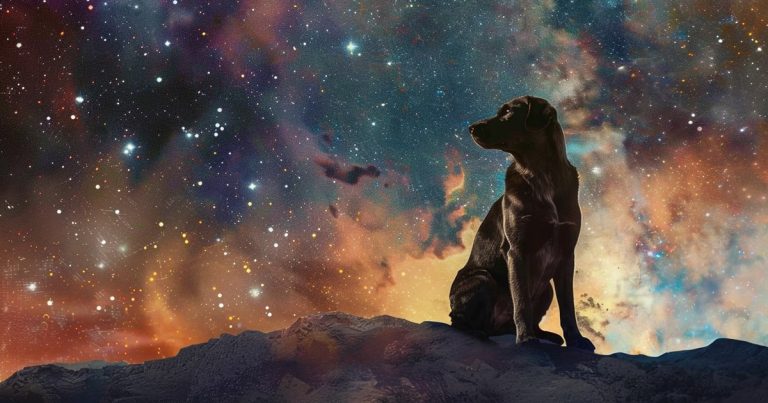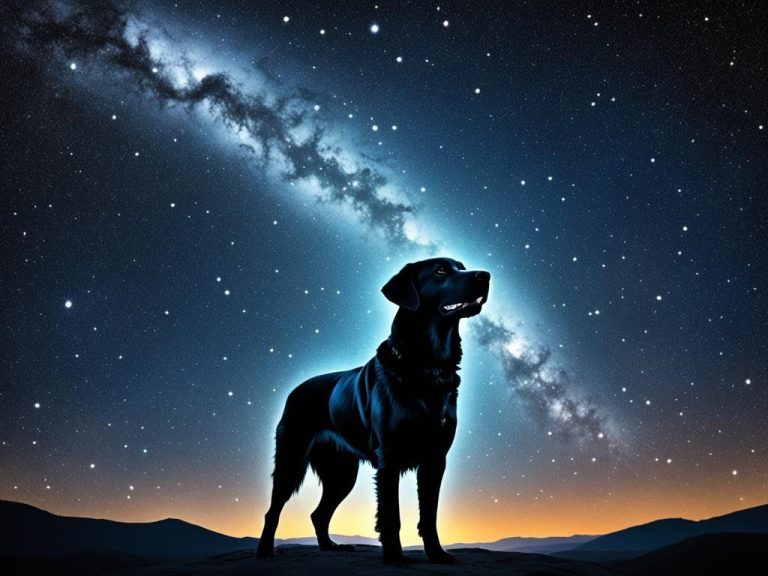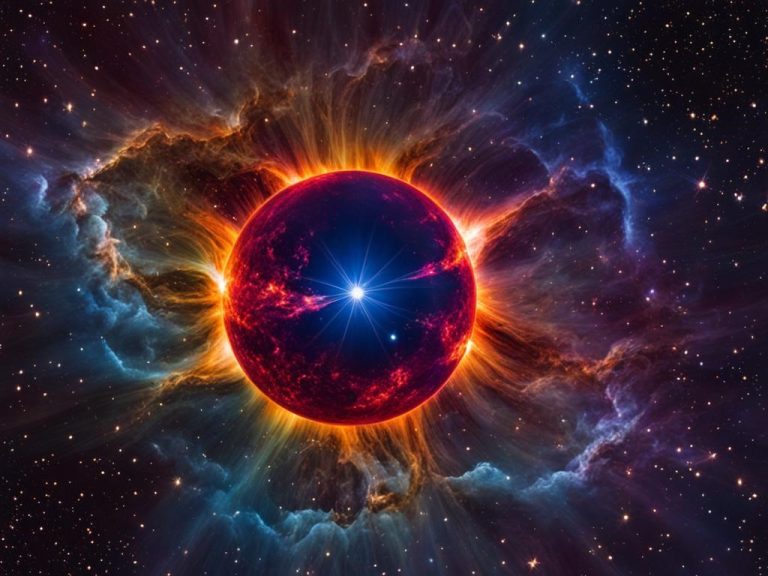Explore the Canis Major Constellation Secrets!
Modified: September 1, 2024 Author: International Star Registry
Did you know that Canis Major has one of the brightest stars? It’s true! This constellation in the southern hemisphere shines with the famous Dog Star, Sirius. Canis Major is full of history, interesting tales, and stars that still fascinate us today.

Key Takeaways:
- Canis Major is a prominent constellation in the southern hemisphere.
- The constellation is home to Sirius, one of the brightest stars in the night sky.
- Canis Major has a rich history and fascinating mythology associated with it.
- Exploring the celestial wonders of Canis Major offers a captivating experience.
- Don’t miss the opportunity to witness the beauty of Canis Major!
The History and Mythology of Canis Major
Canis Major is a well-known constellation with a rich history and mythology. It dates back thousands of years. This area is about 380 square degrees, making it the 43rd largest.
Ancient people connected Canis Major with dogs and wolves. In Greek stories, it was Orion’s loyal hunting dog. So, it’s often called the Greater Dog.[2]
Ancient Mesopotamians also saw the Canis Major. They paid attention to its brightest star, Sirius. They named it KAK.SI.SA2 and thought of it as a Southern Star bow called BAN.[5]
The brightest star in Canis Major is Sirius, or the Dog Star. It’s called the “dog star” because it’s close to our Solar System. And Sirius is the brightest star we see at night.[6]
Canis Major has meant different things to different people. Many cultures saw it as a sign of loyalty and quickness. For example, Greek myth talks about Laelaps, a super-fast hunting dog.[21]
If you want to know more about Canis Major’s history, you can check these resources:
- Wikipedia: Canis Major
- Constellation Guide: Canis Major Constellation
- Ian Ridpath’s Star Tales: Canis Major
Learning about Canis Major adds mystery to the stars. It shows us how ancient people saw the sky. This links us to our past in a special way.
Now, let’s look closer at the famous Sirius star in Canis Major. We’ll discover why it’s so important.
Imagine the joy of owning a piece of the cosmos, a star shining brightly in the constellation of Canis Major, bearing a name of your choosing. With International Star Registry, this dream can become a reality. Naming a star is a unique and heartfelt gesture, perfect for commemorating special occasions such as birthdays, Christmas, or anniversaries. This constellation is a favorite among celebrities. Some celebrities that have their very own stars named in Canis Major include Liberace and Donald O’Connor.
References:
- Constellation Guide
- Wikipedia
Exploring the Dog Star, Sirius
Sirius, known as the Dog Star, is in the Canis Major constellation. It shines the brightest in its region. After the Sun, it is the second brightest star in our sky. This makes Sirius a key star system. It consists of two stars: Sirius A is a visible star. And Sirius B, its white dwarf companion.
Sirius A shines bright and is easily seen without a telescope. Its light is so strong, it draws people who love the night sky. From Earth, it’s just 8.6 light-years away. This makes it one of the closest stars to us.
But, its companion, Sirius B, needs a telescope to see. Even though it’s not visible to the naked eye, it adds to Sirius’s mystery.
Sirius is best seen in the winter from places like Ireland. A clear, dark sky is all you need to see the Dog Star beautifully. For the best view, look from 8 PM to 11 PM in winter.
A telescope can show you not just Sirius, but many other stars in Canis Major. You can find stars like Mirzam and Wezen. They are beautiful stars close to the Dog Star in the night sky.
Besides its beauty, the Dog Star has great meaning in history and culture. The ancient Egyptians and Mali’s Dogon people connected Sirius with dogs and wolves.
For more on Sirius’s history and cultural significance, check out these links: [1], [2], and [3].
Exploring the Dog Star, Sirius, is an amazing experience. Its brightness, binarity, and cultural value make it a star worth studying. For both astronomers and those who love the night sky.
Viewing Canis Major from Earth
Are you into stargazing? Don’t miss Canis Major. It shows off beautiful stars and deep-sky objects. To enjoy it, know the best time and place to look.
In winter, Canis Major shines high in the southern sky. It spans 380 square degrees, so it’s easy to spot. Just be aware, light pollution and weather can sometimes get in the way.
Find Canis Major using star charts or apps for your phone. They tell you where everything is. This way, you won’t miss out on anything when you look up.
Sirius, the Dog Star, is in Canis Major. It’s the brightest star in the night sky. About 8.6 light-years from us, it shines more than any other star.
Want to learn more about Canis Major and its place in astronomy?
- Check out EarthSky’s guide on Canis Major. It covers stars and deep-sky objects.
- Read NASA’s story on Betelgeuse and Canis Major’s mystery connection.
- And don’t forget to visit Star Walk’s guide on Canis Major for history and myths about the constellation.
Canis Major is perfect for anyone fascinated by the night sky. So, get your gear ready for a special journey through the stars.

Notable Stars in Canis Major
Besides Sirius, the brightest star in the night sky, Canis Major has many other bright stars. These stars are famous for their brightness, size, and how far they are from us. This makes Canis Major a special sight in the sky, both beautiful and important for scientists.
Adhara is one such star, shining from about 430 light-years away. It dazzles the night with its blue-white light. Adhara is among the most stunning stars in the Canis Major.
Wezen is a star that’s even farther away, about 1,800 light-years. It shines really bright and blue. With a brightness much more than our Sun, Wezen is a key part of Canis Major’s beauty.
Mirzam, or Beta Canis Majoris, is about 500 light-years from us. It glows a bright white-blue. This makes Mirzam stand out among the other bright stars in the area.
Omicron Canis Majoris is yet another star, about 1,100 light-years away. Though not as bright as some, it’s a red supergiant. Omicron Canis Majoris shows the wide variety of stars in this constellation.
The stars in Canis Major, like Adhara, Wezen, Mirzam, and Omicron Canis Majoris, show us the universe’s grandness and beauty. They catch the eyes and hearts of both those who study the stars and those who simply enjoy looking at them. They teach us to wonder at the beauty of Canis Major and what lies beyond it in the sky.
Deep Sky Objects in Canis Major
Canis Major is famous for its bright stars and deep sky objects. For example, Messier 41 is an open cluster. It can be seen with binoculars or a small telescope. The cluster has about 100 stars and is 2,300 light-years away. It’s roughly 190 million years old and looks stunning in the night sky.
The Canis Major nebula, or NGC 2359, is another amazing find. It’s an emission nebula shaped like a wolf’s head. People also call it “Thor’s Helmet.” This stunning nebula is about 30 light-years wide and 15,000 light-years away. It’s a favorite among astrophotography lovers for its beauty.
Canis Major also boasts objects like the NGC 2477 and NGC 2354. The NGC 2477 is a big, packed cluster with thousands of stars, located 4,000 light-years away. The NGC 2354, however, is a loose cluster with its stars spread out. Both objects show the cosmos’s vastness and natural beauty in Canis Major.
If you love astronomy or are just curious, exploring Canis Major’s deep sky objects is thrilling. These wonders show us the vast and varied universe. They remind us of the beauty found beyond our planet.
The Fascinating Behavior of VY Canis Majoris
VY Canis Majoris is a red hypergiant star in the Canis Major constellation. It has amazed astronomers and scientists. With a diameter about 1,420 times that of our Sun, it’s one of the biggest stars we know.
It dims at times, similar to Betelgeuse. But, its dimming events are much bigger. Scientists think these dim changes happen when the star throws out a lot of stuff.
VY Canis Majoris helps us understand how stars change and end. By looking at its life stages, astronomers learn a lot about these massive stars.
Want to know more about VY Canis Majoris and other cool stars? Check out these resources:
- Learn about supermassive stars with this article on Steemit.
- For detailed info on stars, check out the chapter on the H-R diagram in this astronomy course at Lumen Learning.

Scientists keep looking at stars like VY Canis Majoris. This helps us see more of the universe’s complexity.
The Intriguing Evolution of Canis Major
Canis Major is known as the celestial dog. It gives us a unique view of how stars change across the cosmos. This constellation is full of different stars that teach us about the life of a star.
Canis Major shows us how stars evolve. It starts with hot, bright blue stars. Then, it leads to huge red stars like VY Canis Majoris, showing an amazing journey.
This evolution teaches us a lot about stars and the big cosmic forces at work. Astronomers learn a great deal about the universe by looking at these changing stars.
Unique Characteristics of Canis Major
Canis Major is special not just for how its stars change but also for the kinds of stars there. You’ll find many different stars classified by their size, temperature, and brightness here.
From bright blue giants to stars that change in brightness, Canis Major is a treasure trove for astronomers. It opens new doors of knowledge with every star they discover.
The Classifications of Canis Major Stars
Stars in Canis Major are grouped by their spectral types. This tells us about their make-up and heat. O stars are the hottest, while M stars are cooler and smaller.
Canis Major also has stars that change how bright they look. These changing stars help scientists learn more about all stars. They make the story of Canis Major even more interesting.
Studying Canis Major’s stars helps astronomers understand how stars are born and change. It reveals many secrets in the vast expanse of this constellation.
Canis Major in Different Cultures
Canis Major has always been a significant part of cultures worldwide. From old stories to today’s science, it has a big meaning. Different groups have looked at Canis Major in their own ways.
In Greek stories, Canis Major was Orion’s loyal dog, Laelaps. These myths tell the tale of their adventures. They were both honored by being turned into stars in the sky.
Egyptians saw Sirius, the brightest star in Canis Major, as special. They thought it helped bring the Nile’s yearly floods. To them, it was a sign of good harvests and new life.
Native Americans had their own stories about Canis Major. To some, it was a way to explain the sky’s patterns. For others, it helped them understand the changes of the seasons.
Today, astronomers value Canis Major for its beauty and for what it teaches about space. They study its stars and learn about the universe. This work is ongoing.
Canis Major is more than a group of stars. It’s part of stories that have lasted for ages. People see its connection to bravery, hunting, and loyal friends. This makes us think about its role in different cultures.
Conclusion
Exploring Canis Major has let us learn about its secrets and marvels. This captivating constellation has a rich history and mythology. It has not just notable stars but also deep sky objects.
Canis Major showed us the famous Dog Star, Sirius, that shines brightly. We also discovered VY Canis Majoris, which is an exceptionally large star. This exploration gives insights into how stars live and die.
Canis Major is important in many cultures, each giving it different meanings. Its stories and myths make it even more fascinating. Looking up at Canis Major makes us feel the vastness and beauty of the universe.
FAQ
What is the Canis Major Constellation?
The Canis Major Constellation is a key constellation in the south. People know it for its bright star, Sirius or the Dog Star.
What is the mythology and history behind Canis Major?
Humans have known Canis Major for thousands of years. It has been linked to dogs, wolves, and more in ancient stories. Greek myths connect it with hunter Orion and his loyal dog.
Which star is the brightest in Canis Major?
The brightest star is Sirius, the Dog Star. It shines not just in its own constellation but the entire night sky.
Where can Canis Major be viewed from on Earth?
It’s best seen from places on Earth, especially in winter. Viewing it depends on how bright the night is and the weather.
What are some notable stars in Canis Major?
Canis Major boasts stars like Adhara and Wezen. It also has some deep sky objects, making it truly special in the sky.
Are there any deep sky objects in Canis Major?
Yes, it has features like the Messier 41 open cluster. Nebulae and star clusters here are great for those who love looking at the night sky.
What is unique about the star VY Canis Majoris?
VY Canis Majoris is a huge, red star with unusual changes in brightness. Giant explosions of gas might be causing these changes.
How has Canis Major evolved over time?
It has changed over time, with stars going from hot blues to red supergiants. The mix of stars here makes it very fascinating to study.
What is the cultural significance of Canis Major?
Canis Major is important in many myths and traditions. It connects to dogs, hunting, and hero stories from different times.
What makes Canis Major a captivating constellation to explore?
People have found Canis Major interesting for a long time. Its bright stars, stories, and deep sky wonders draw in astronomers and sky watchers. It helps us see the amazing and complex universe we live in.
Source Links
- Hubble Solves Mystery of Monster Star’s Dimming – NASA Science – https://science.nasa.gov/missions/hubble/hubble-solves-mystery-of-monster-stars-dimming/
- Canis Major: The Dog Star Constellation and Its Spectacular View from Ireland – https://stargazingireland.com/canis-major/
- Canis Major – https://en.wikipedia.org/wiki/Canis_Major
